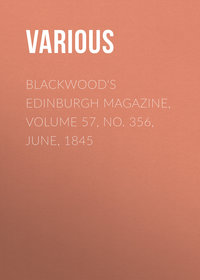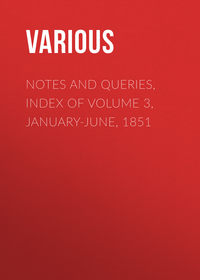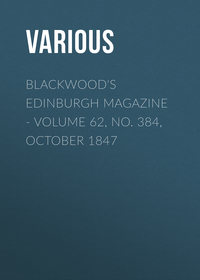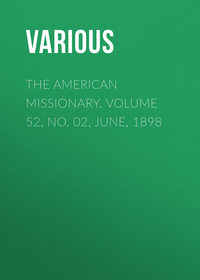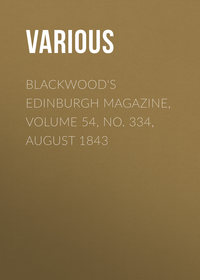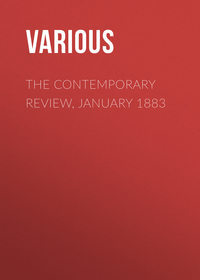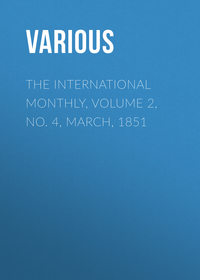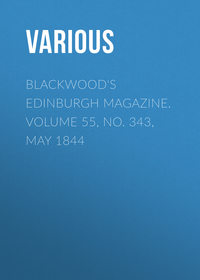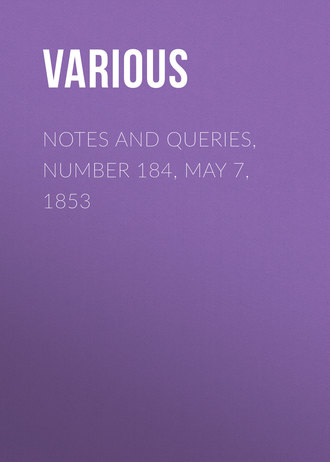 полная версия
полная версияNotes and Queries, Number 184, May 7, 1853
Oxford.
THE SIGN OF THE CROSS IN THE GREEK CHURCH
(Vol. vii., p. 380.)The cross, X, in the Greek Church, represents the initial of Χριστὸς, the Messiah, the symbolic affixing of which (sealing) before and after baptism indicates that the name of Christ is imposed on the believer, who takes his new or Christian name at baptism. This mark on the forehead refers to Revelation vii. 3., xiv. 1., xxii. 4. The longer catechism of that church, in answer to the question, "What force has the sign of the cross, used on this and other occasions?" says, "What the name of Jesus Christ crucified is, when pronounced with faith by the motion of the lips, the very same is also the sign of the cross, when made with faith by the motion of the hand, or represented in any other way." The authority quoted is Cyril of Jerusalem (Cat. Lect. xiii. 36.).
In the Western Church the cross,

Both these crosses are now found in the Greek Church; and the Latin form,

The Latin cross,

"Illud autem fatendum nobis est, nullatenus ante felicissima Constantini Magni ad fidem traducti tempora crucem publicæ populorum venerationi expositam fuisse."—Vol. ii. lib. vi. c. xiv. p. 546.
The following statement from Humphrey's Montfaucon (vol. x. part ii. book iii. cap. 1. p. 158.) is very clear as to the form of the cross:
"The cross, made with beams put together, had the shape of the Samaritan tau, says St. Jerome, whose words are these: 'In the oldest Hebrew letters, which the Samaritans now make use of, the last, which is tau, had the form of a cross.' This tau, like a cross, was like the Τ of the Greeks, according to Paulinus, who says that the shape of the cross is expressed by the Greek letter tau, which stands for three hundred. The cross of our Lord was something different from the letter tau; the beam that was fixed in the earth crossing that which was athwart it above, and made as it were a head by rising above it: such a cross we see in the medals of Constantine the Great, in this form,

The Greek church has retained both forms: the Latin Church, in its ignorance of the Greek language, has lost the more important symbol. These forms were probably invented by Constantine, who used them on his helmet, as crests were afterwards used in the ages of chivalry.
T. J. Buckton.Birmingham.
The difference between the manner in which the members of the Greek and those of the Latin Church used to sign themselves with the sign of the cross is this: both used the right hand, the thumb and first and second fingers open, and the third and fourth closed; both began at the forehead, and descended to the breast: but in crossing that vertical line by an horizontal one, from one shoulder to the other, the Greeks go from the right to the left, but the Latins from the left to the right. It is said, that in the Latin Church, up to the thirteenth century, the cross line was traced indifferently from either shoulder.
Whilst there is this difference between the Greek and Latin sign of the cross when made upon oneself, there is also a difference between the two when made upon others. The Latin Benediction is given with the thumb and the first two fingers open; the third and fourth fingers remaining closed. This arrangement of the the fingers is symbolical of the Trinity: the three open fingers signifying the three divine persons, and the two closed fingers being emblematic of the two natures of Christ.
The Greek benediction is given with the forefinger entirely open; the middle finger slightly bent, the thumb crossed upon the third finger, and the little finger bent.
In the present day, however, in the Latin Church, a person making on himself the sign of the cross, employs the right hand entirely open, instead of three fingers only. And as it has been thought desirable to make a distinction between the benediction given by a bishop and a priest, bishops reserved to themselves the right of blessing with three fingers; and priests give the benediction with the hand entirely open.
J. C. B. will find this subject fully treated in Didron's Christian Iconography, Bohn's edition, pp. 405. 412.; and an illustration of the Latin benediction at p. 205., and the Greek benediction at p. 176.
Ceyrep.PHOTOGRAPHIC NOTES AND QUERIES
New Developing Fluid.—Dr. Diamond has reported very favourably of the developing fluid, which I spoke of in "N. & Q." of March 12 as "being simple, inexpensive, and keeping good a length of time." In accordance with what I then stated, I herewith give the readers of "N. & Q." the benefit of it, and leave them to form their own opinion of its value after trying it:
Protosulphate of iron – 12 grs.
Nitrate of lead – 8 grs.
Water – 10 drs.
Acetic acid – ½ dr.
Dissolve the protosulphate of iron in the water; then throw in the nitrate of lead in powder; stir with glass rod until it is dissolved; keep stirring while pouring in the acetic acid, and for a few minutes afterwards. Let the precipitate subside, then filter. I have used nothing else for positives on glass since I discovered the preparation. I have not tried it for developing in the wax-paper or other paper process. The liquid is colourless as water when first made. By long keeping it will change colour, but throws down no deposit, nor loses its properties. If those gentlemen who try it would give their opinions of it, I should be obliged.
J. L. Sisson.Edingthorpe Rectory.
[Since this was in type, Mr. Sisson has written to say, that he has been informed that the use of nitrate of lead has already been recommended by Mr. W. Brown. Mr. Sisson was not aware of that fact, but is unwilling to appear in any way to appropriate to himself the suggestion of another.—Ed.]
Photographic Tent.—Can any of your readers inform me how, or where, to procure an effective tent for photographic operations out of doors? All those I have yet seen are sadly wanting in the two great essentials—portability and cheapness. If any one could suggest the means for supplying the desiderata, it would prove in the coming season a boon to photographers at large, and confer a favour on
M. F. M.Mr. Wilkinson's simple mode of levelling Cameras.—The following ingenious suggestion appears in the 3rd Number of the Journal of the Photographic Society, and deserves to be widely circulated. "My plan is to place a T-square on the bottom of the camera, and draw one perpendicular line on each side (exactly opposite to each other), either with paint or pencil; or the ends of the camera itself will do if perpendicular to the base. Then, having two musket bullets attached to a silk thread, simply hang them over the camera, and everything required will be attained much quicker by these plumb-lines, and with accuracy equal to the spirit-levels. The advantage of the simple contrivance of two bullets suspended by threads is, that when the thread is laid across the camera, it is at once seen whether the thread touches all the way down both sides; if not, one or other side of the camera is raised, until the thread lies close on each side: this gives the level crossways. The other perpendicular of the line is then sought for, and the back or front of the camera raised or lowered, until the thread cuts the line drawn below. Here then we have the most perfect line that can be obtained, at the expense of two bullets and a bit of silk, answering every purpose of the best spirit-level, and applied in one-half the time. It has since occurred to me, that as we sometimes require to measure the distance for stereoscopic pictures, this thread ought to be about three feet long; and we might as well make three knots, and then we should have the measure of a three-feet rule always with us. It has also occurred to me, that in taking portraits you sometimes require to have a measure of time; and by a little modification we have here the most accurate chronometer that can be produced. Instead of three feet, I make it thirty-nine inches and the decimal necessary, say two-tenths from the centre of support to the centre of the bullet. I then get a pendulum which vibrates to second exactly, from the point of suspension to the point of oscillation. I hang it by a pin, and I there have a chronometer of the greatest possible accuracy; and I can employ it for taking portraits of one, two, three, or four seconds: it will vibrate for a minute. Consequently I have a mode of levelling my camera with the greatest accuracy, a measure of time, and a measure of distance; and all at a cost considerably under one penny."
Antiquarian Photographic Club.—This association for the interchange of photographic views of objects of antiquarian interest, has now nearly attained the number of members to which it is proposed to limit it. For the few remaining vacancies preference will be given, for obvious reasons, to parties resident in varied localities. Any gentlemen or ladies desirous to join the club, may send their names, with specimens of their skill, to the Honorary Secretary, care of Mr. Bell, 186. Fleet Street. The amount of the annual subscription is not yet fixed, but as all that can be required will be to meet the expenses incident to the receipt and interchange of the photographs, it must necessarily be very limited.
Replies to Minor Queries
Erroneous Forms of Speech: Mangel Wurzel (Vol. vii., p. 329.).—Against the dictum of E. G. R., I beg insertion of the following quotation from the Agricultural Gazette, March 4, 1848, p. 166.:
"Mangold wurzel is simply the German of beet-root. 'Mangel wurzel,' on the other hand, is one founded on an idea, which, though absurd, did not the less effectually answer the object of those who introduced the plant. 'Scarcity root,' or 'Famine root,' made a good heading to an advertisement."
And Rham, Dictionary of the Farm, p. 62.:
"The German name is 'Mangold wurzel,' or 'Mangold root;' but it is sometimes pronounced 'Mangel wurzel,' which means scarcity root; and, by a strange translation, it is called in French racine d'abondance, as well as racine de disette. The name of field-beet is much more appropriate."
I hope E. G. R. will, however, not insist on classing those who say and write "mangold" with those who would write "reddishes, sparrowgrass, and cowcumbers." I should be sorry to be suspected of any one of the three last; but "mangold" I will say and write till the authority of the best German scholars decrees otherwise.
Geo. E. Frere.The Whetstone (Vol. vii., pp. 208. 319.).—Herbert, in his Typographical Antiquities, vol. ii. p. 1144., cites a book entitled, Fower great Liers striving who shall win the Silver Whetstone. Also a Resolution to the Countreyman, proving it utterly unlawful to buy or use our yearely Prognostications, by W. P.: 8vo., printed by R. Waldegrave; no date.
H. C.Charade (Vol. vi., p. 604.).—
"By mystic sign and symbol known,To Daniel, wise and meek, alone,Was Persia's coming wo foreshown."And in great Cæsar's proudest day,The Gospel held a mightier sway,And man shone forth with purest ray."But when, in Babylonia chain'd,Man of his deepening wo complain'd,A woman conquering both, in faithful Esther reign'd."Sophronia Sphynx.Parochial Libraries (Vol. vi., p. 432. &c.; Vol. vii., p. 392.).—Totnes may be added to the list of places containing parochial libraries. The books are placed in presses in the vestry room of the church, and so preserved from loss and damage to which they were formerly subjected. The collection is principally composed of works of divinity published in the seventeenth century, the age of profound theological literature. I noticed amongst the goodly array of weighty folios, the works of St. Augustine, the Homilies of St. Chrysostom, works of St. Ambrose, St. Gregory, &c., the works of the high and mighty King James, Birckbek's Protestant Evidence, and Walton's Polyglott. Nothing is known of the history and formation of this library. Inside the cover of one of the volumes is the following inscription:
"Totnes Library. The guift of Mr. Thomas Southcott, July 10. 1656."
I found the following incorrect and antiquated piece of information respecting this library in a flimsy work, published in 1850, entitled, A Graphic and Historical Sketch of the Antiquities of Totnes, by William Cotton, F.S.A., note, p. 38.:
"I know not what the library contains. I believe nothing more than theological lumber. It is always locked up, and made no use of by those who keep it, and it is inaccessible to those who would wish to examine it. I was once there by accident, and looked into some books, which were all on Divinity."
J. M. B.Tunbridge Wells.
Judge Smith (Vol. vii., p. 13.).—Judge Smith lived towards the close of Queen Elizabeth's reign, and was noted for severity against witches. His monument is in Chesterfield Church. He belonged to the ancient family seated at Dunston Hall, near that town, which I believe has lately ended in co-heiresses. The late Sir J. E. Smith was of the same family: his father, a considerable merchant of Norwich, married a Kindersley descended from Geoffrey,—who was queried in Vol. vi., p. 603., and is ancestor of the present Vice-Chancellor.
Z. E. R.Church Catechism (Vol. vii., p. 190.).—B. H. C. will confer a favour by printing the Latin original of the Catechism.
Z. E. R.Charade attributed to Sheridan (Vol. vii., p. 379.).—Several years ago, I think in 1818 or 1819, a friend gave me some verses nearly similar to those communicated by your correspondent Balliolensis, and requested me to ascertain if they were Mrs. Piozzi's, as my friend had been told that they were written by that lady. Soon afterwards I asked Mrs. Piozzi if she ever wrote a riddle on a gaming-table. She replied, "Yes, a very long time ago." She immediately repeated a line or two, and, after some consideration, recited the following, which, she assured me, were her original composition. These lines, it will be observed, differ somewhat from those attributed to Sheridan, but they were probably the basis of those, and also of other versions of the riddle, which, I believe, are in existence. This statement so thoroughly removes all uncertainty about the author of the original, that I trust you will deem it worthy of insertion in your journal.
"A place I here describe, how gay the scene!Fresh, bright, and vivid with perpetual green,Verdure attractive to the ravish'd sight,Perennial joys, and ever new delight,Charming at noon, more charming still at night.Fair pools where fish in forms pellucid play;Smooth lies the lawn, swift glide the hours away.No mean dependence here on summer skies,This spot rough winter's roughest blast defies.Yet here the government is curs'd with change,Knaves openly on either party range,Assault their monarch, and avow the deed,While honour fails, and tricks alone succeed;For bold decemvirs here usurp the sway;Now all some single demagogue obey,False lights prefer, and hate the intruding day.Oh, shun the tempting shore, the dangerous coast,Youth, fame, and fortune, stranded here, are lost!"J. S. S.Bath.
Gesmas and Desmas (Vol. vii., pp. 238. 342.).—The names of the two thieves crucified with our blessed Saviour are variously written. In the verses quoted by A. B. R. (p. 238.) they are written Gesmas and Desmas. In the edition of the Gospel of Nicodemus, quoted by W. C. H. (p. 342.), i.e. the edition of "William Hone, Ludgate Hill, 1820," the names are written Gestas and Dimas. He also gives an authority for the spelling "Dismas and Gestas." I find them written in the edition I have of the Gospel of Nicodemus, i. e. "Hutman's, London, 1818," Dismas and Gesmas (pp. 87, 88.). Elsewhere I have met with them written as in the following verse, Gistas and Dismas:
"Gistas damnatur, Dismas ad astra levatur,"which I have ventured to translate:
"Gistas to hell—with Dismas all goes well;"or perhaps better thus:
"Gistas goes down, Dismas receives a crown."The names of these two men in early life is said to have been Titus and Dumachus: see the Evangelium Infantiæ, quoted by Hutman (p. 13.).
Ceyrep.Lode (Vol. v., pp. 345. 350.).—There is in Gloucester a church and parish called Saint Mary de Lode, touching which Mr. Fosbroke (History of City of Gloucester, p. 341.) observes:
"This parish is said to have derived the adjunct of Lode from the Severn formerly running near it; and this may have been the fact, but it is not easy to give a satisfactory explanation of the term."
I would remark, that as the term Lode may be considered a general name for any navigable river, that if it be a fact that the river Severn did formerly run near the parish in question, it appears to me not difficult to give a satisfactory explanation of the term by which such parish is distinguished from St. Mary de Crypt and St. Mary de Grace.
C. H. Cooper.Cambridge.
Epitaphs imprecatory (Vol. vii., p. 256).—I have no doubt that the churchyards of Scotland will furnish many examples of the embittered feelings which religious persecution produced, during the latter half of the seventeenth century; and as a specimen I forward the following, which is found in the churchyard of Dalgarnock, in Dumfriesshire. The Duke of York alluded to was afterwards James II.; and the descendants of Mr. Harkness are still most respectable inhabitants of the parish of Closeburn, which has been united to Dalgarnock:
"Here Lyes the body of James Harkness, in Locherben, who died 6th Dec. 1723, aged 72 years.
"Belo this stone his dust doth ly,Who indured 28 yearsPersecution by tirranyDid him pursue with echo and cryThough many a lonesome place,At last by Clavers he was taenSentenced for to dy;But God, who for his soul took care,Did him from prison bring,Because no other Cause they hadBut that he ould not give upWith Christ his Glorious King.And swear allegence to that beast,The duke of York I mean.In spite of all there hellish rageA natural death he diedIn full assurance of his restWith Christ ieternalie."The following may be given as an example of a punning epitaph. It is found in St. Anne's churchyard, in the Isle of Man, and is said to have been written by Sir Wadsworth Busk, who was for many years attorney-general of the island:
"Here, Friend, is little Daniel's Tomb,To Joseph's age he did arrive;Sloth killing thousands in their bloom,While labour kept poor Dan alive.Though strange yet true, full seventy yearsWas his wife happy in her Tears.Daniel Tear died December 9th, 1787, aged 110 years."
C. T. R.Straw-bail (Vol. vii., pp. 85. 342.).—The origin of the expression "a man of straw" may be traced to those mannikins or effigies representing the human figure, which are (or used to be) paraded in the streets during the Carnival in most continental countries. These mannikins were generally stuffed with straw; and hence, in legal phraseology, "a man of straw" denotes the semblance of a man—a person of neither substance nor responsibility, who is put forward to screen a real delinquent, or bear the brunt of a prosecution. Such, at least, is the origin commonly assigned by the French to their "homme de paille," the prototype of our "man of straw."
Henry H. Breen.St. Lucia.
How to stain Deal (Vol. vii., p. 356).—If C. will apply by letter or otherwise to Mr. Henry Stevens, 54. Stamford Street, Blackfriars Road, he will learn every particular, and be furnished with samples of its effect on common deal, as now very extensively used in churches, school-rooms, &c.
Detached Belfry Towers (Vol. vii., pp. 333. 416.).—Add to the list, Marston Morteyne in Bedfordshire, not far from Ampthill, and Gunwalloe, in Cornwall, about five miles south of Helston. Gunwalloe tower appears to be much older than the church, and faces the south-west angle of the nave, from which it is distant about fourteen feet.
J. M. B.Tunbridge Wells.
Cambrensis has forgotten that the cloich teachs (bell-houses), or round belfries, peculiar to Ireland, and which have become famous as "round towers," are almost always separate from the churches.
James Graves.Kilkenny.
To your instances of detached belfries in England add Magdalene College and New College in Oxford, and Woburn in Bedfordshire.
H. C.Thurles.
Detached church-towers exist at Beccles, Suffolk, and at East Dereham, Norfolk.
G. J. C.Oxford.
Miscellaneous
NOTES ON BOOKS, ETC
The anniversary of the Camden Society on Monday last, when Mr. Peter Cunningham, Sir F. Madden, and Sir C. Young were elected on the Council, was distinguished by two departures from the usual routine: one, a special vote of thanks to Sir Harry Verney for placing his family papers at the service of the Society; and the other, a general expression of satisfaction on the part of the members at the steps taken by the Council to bring under the consideration of the Commission appointed to inquire into the laws regarding matters testamentary, the great impediments thrown in the way of all historical and literary inquirers by the authorities in the Prerogative Office.
It does not require the skill of an Œdipus to divine that in giving us so graphic a picture of The Vicar and his Duties, the Rev. A. Gatty has had the advantage of sketching from the life, and that his portraiture of
"A good man of religiounThat as a poore Persone of a toun;But riche he was of holy thought and werke."is as much a true effigy, though taken with pen and ink, as if he had put that capital parish priest, the Vicar of Leeds, before his camera. To the many friends of Dr. Hook, this little volume will be deeply interesting.
Books Received.—Pulleyn's Etymological Compendium, or Portfolio of Origins and Inventions. Third Edition, revised and improved, by Merton A. Thoms. This new edition of a very popular and useful little book has had the advantage of a thorough revision, and contains much new and interesting information.—Longman's Traveller's Library has lately been enriched by two of Mr. Macaulay's brilliant essays, viz. on Lord Byron and The Comic Dramatists of the Restoration, and by a carefully compiled life of Marshal Turenne by the Rev. T. O. Cockayne: while Mr. Murray has added to his valuable collection of Railway Readings, a reprint of The Life of Lord Bacon, by his noble biographer Lord Campbell.—Reynard the Fox, after the German Version of Göthe, with Illustrations by J. Wolf. Part V. This translation is kept up with spirit, and the present number carries us to The Pardon of the wily transgressor.—Mr. Bohn has put forth numerous fresh claims on the favour of poor scholars: in his Standard Library he has given a third volume of Miss Bremer's Works, containing Home and Strife and Peace; in his Classical Library he continues the translation of Aristotle in The Politics and Economics, translated by G. Walford, M.A.; in his Antiquarian Library, he has continued in his series of translations of Early English Chronicles by giving us in one volume a translation of Henry of Huntingdon, and also of the Gesta Stephani; while he will have done good service to naturalists and keepers of aviaries and cage birds by the edition of Bechstein's Cage and Chamber Birds and Sweet's Warblers, which he has included in the same volume of his Illustrated Library.




